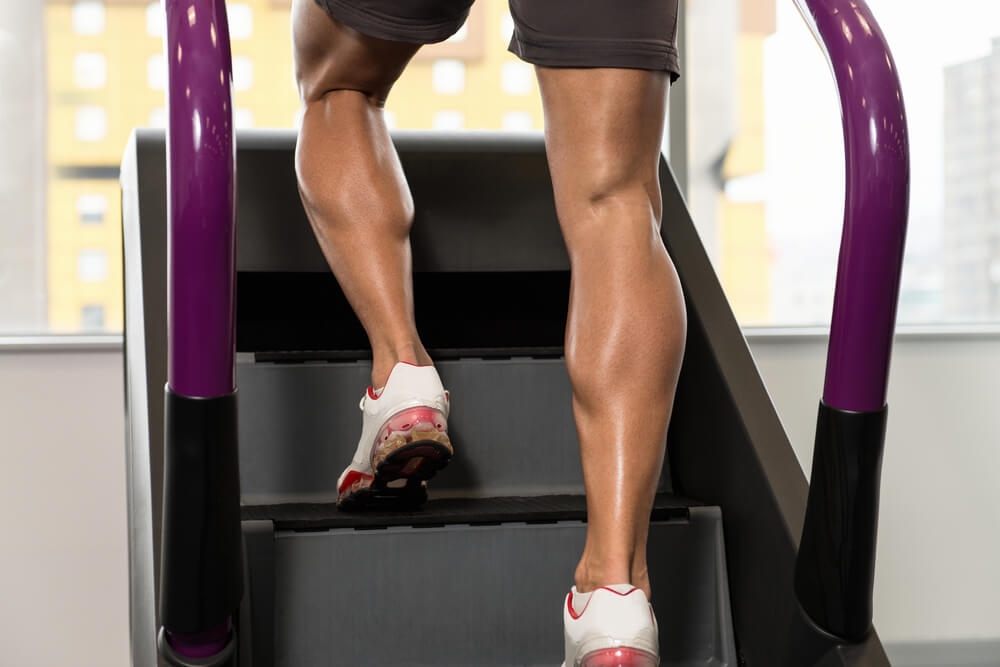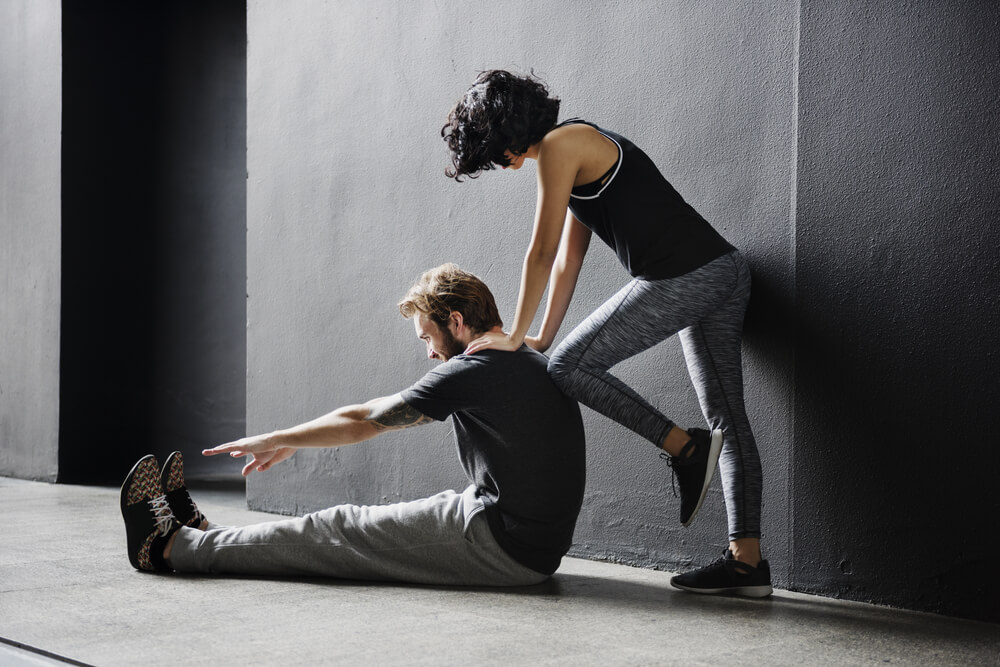
Should you do cardio after lifting or before you lift?
The debate is over! Read on to find out what’s right for you and how to get the most out of every session!
Workout routine: 20 minutes of cardio machines, lift, abs, repeat.
Sound familiar?
Does the scale read the same number every week?
You’re not alone. The jury is in, adding cardio to your weight lifting workout schedule might not just be counter-productive, it could also be taking away from the progress you’ve already made.
The good news is, we’re here to tell you when cardio is a good idea and even how to do it so as not to lose your gains.
Are you ready?
Here Is A Quick Biology Review
Ask any lifter what he or she takes before they train. Undoubtedly it’s some kind of mix that contains caffeine and, more often than not, creatine.
Both of these substances stimulate and speed up the creation of an organic molecule in your body called adenosine triphosphate, or ATP.
ATP is responsible for every rep of every exercise you perform. It’s a biological unit that accounts for energy.
Basically what happens is your body breaks down carbohydrates and makes this molecule, which allows you to lift. It stores it in two places: Your skeletal muscles (the ones you use to lift) and your liver.
Exercise of any form is going to use ATP, because unlike stimulating muscle growth, all muscular moves require ATP, even running and jumping rope. And the body will flood the area that needs ATP the most.
This Is Why Cardio After Lifting or Before Matters…
Here’s the bad news: Your ATP stores are limited.
Cardio fitness will tap into the ATP that’s stored in your liver, but those stores are also limited and guess where cardio will pull from after it’s depleted your liver stores of ATP: Your muscles.
This means that when you finally slog through all your cardio machines and get to the squat rack, your body literally will not have the energy to do the squats you planned on doing.
This is all measurable by looking at the levels of certain substances in your blood. No, you don’t have to take your own blood and test in your gym workout routine. That would just be silly and impractical, not to mention super expensive.
I can hear the cries now, “but how am I supposed to warm up?”
That’s easy. We’ll address that later. For now, here’s the verdict on when to do cardio: Do your cardio after lifting.
Why?
Simple, your body will draw first from the muscular ATP stores because of the energy system you are using. In other words, you’ll be working on muscle building and your body will pull from the liver to give you more ATP in your muscles while you are resting between sets.
Want some more good news? Who doesn’t?
When you do come around to doing cardio, your body will be breaking down your fat stores to replenish the liver ATP that you used to replenish your muscle stores.
These Are The New Rules of Cardio Fitness
If you’re a pretty serious lifter, chances are that your goal in the gym is at least somewhat appearance-related, hence why you are doing cardio in the first place. You want to burn off that beer you had with your buddies while watching the game last night or that delicious steak-and-potatoes dinner you had with your significant other.
Gone are the days of 90 minutes of boring walking on incline cardio machines. You’ll be done with this cardio routine in 30 minutes and on your way to your date in no time.
Interval training is the way to go. Hop on one of the treadmill cardio machines or a bike and go at a moderate pace for about five minutes to warm up. Then comes the working portion. Up the resistance and sprint or pedal hard for 20 seconds, then rest 40 seconds. Repeat 20 times for a total of 20 minutes. Then drop the difficulty down to a slower pace to cool down and hit the showers.
There is another set of options you have as well. Go find a football field or at least a 25-yard patch that you can run on. Your three options are running 100 yards in 20 seconds or less with 60 seconds rest between sets, 200 yards in 40 seconds with 90 seconds between sets, and 300 yards in 60 seconds with 2-minute rest between sets. Once you’ve run 1,000 yards or more, you can call it a day and head home. And that’s your home workout.
This is how the NFL, NHL, NBA, MLB and just about every college or relevant sports team in any sport conditions their athletes so fair warning: It’s not for the faint of heart, but is it a damn good workout!
What About That Warm-Up You Promised Us?
Right, the warm-up! There are a number of things you can do to generally warm up, but chances are you may not be doing the right things, and you’re not alone there either. Most trainers don’t even know how to warm up their clients properly for a workout.
So what do you do currently?
Is it five minutes on one of the treadmill cardio machines and some stretching? Is it a few push-ups?
They could be good warm-ups, but the warm-up has to be relatable to your workout.
For example, you wouldn’t turn on your oven if you were going to sauté something on the stovetop, right?
The same goes for your gym workout.
Don’t hop on the treadmill for five minutes if you plan on hitting the bench first. Below is an example of what to do for a warm-up for some common starting moves.
Starting Move: Squat
Warm-up: Five minutes of foam rolling, 10 toe-touch squats (bodyweight), 10 single-leg Romanian deadlifts (also bodyweight) and 2 light sets of squat with about 50% of your working weight for 5 reps and 80% of your working weight for 3 reps. See the following for the how to on some of these exercises.
Starting Move: Bench Press
Warm-up: Five minutes of foam rolling, 10 light bent-over rows (just the bar is fine), 10 scap push-ups and 2 light sets of bench, as described in the section on the squat in the portion before this.
Starting Move: Deadlift
Warm-up: Five minutes of foam rolling, 10 single-leg glute bridges, 10 light (just bar) Romanian deadlifts, then two light sets of deadlifts, as described in the section on the squat a couple of moves prior to this.
How To: Toe-Touch Squat
With straight legs, reach down and grab on to your toes. Keeping your hands on your toes, drop your butt down to your heels, staying tall in the chest, then raise one hand overhead, then the other, then stand up. Repeat for 10 reps.
How To: Scap Push-up
Get on the floor into a push-up position with arms full extended. Now without bending your arms, squeeze your shoulder blades together, pause for a second and then push your shoulder blades back into position. Repeat for 10 reps. This is one of the great shoulder workouts .
How To: Single-Leg Glute Bridge
Lie on your back on the floor, knees bent and feet flat on the floor. Extend one of your legs so the foot is off the floor. Drive the heel of the grounded foot hard into the floor and squeeze the glute on that side to lift your hips into the air. Hold for a second and then bring your hips back to the floor. Repeat for 10 reps, switch sides and repeat.
Cardio Day Warm-up
Start with a brisk walk, rest a few minutes, then a light jog for 5 minutes or so, and do a 1-minute plank. You should be ready to go after that.
Now For More On Cardio
Now that we’ve told you when to do it, we’re going to address some common misconceptions about what is cardio. The first misconception we’ll address is fasted cardio (cardio without eating).
These people who do this say they do not like exercising after eating. Cardio without eating is like driving a car that’s running on fumes.
It’ll still be able to go for a little while, but eventually it will break down, just like you will if you do cardio without eating, especially if it comes after lifting.
More bad news, unfortunately, unlike a car, you can’t just go get fixed in the shop. Chances are that, after a while of doing fasted cardio (meaning a prolonged period of weeks or months), the only shop you’ll be going to is a hospital bed with a condition called rhabdomyolosis.
This can lead to kidney failure and death. Don’t let it get to that point, because I can promise you, abs aren’t worth dying for.
That’s a major buzzkill!
Then there’s the question of how much is enough?
Thirty minutes of cardio is all you ever need unless you’re training for a marathon, triathlon or something endurance-focused event. I wouldn’t advise going above 30 minutes.
Why?
Simple, because that can also land you in a bed with rhabdo and anyone who’s ever had it will tell you that it’s no fun. That’s not to mention that you’ll have to significantly scale back your training, killing your gains in both strength and size.
You’ll basically have to go back to square one, which will be extremely frustrating and has made some people give up altogether.
The next major myth we’ll bust is the whole fat burning versus heart rate training thing. There are all types of easy diet plans and supplements the people at Vitamin Shoppe, GNC, or any other sports nutrition place will try and sell you by telling you that their product or method will help you shed the fat.
Sadly, the only real way to do it is by reducing your caloric intake (how much you eat) and increasing caloric output (how much exercise you do on a given day).
The type of cardio that helps you burn the most in a given unit of time (say, 20 minutes like we covered before) is interval training. Spoiler alert: No matter what your treadmill says about heart rate zones for fat burning versus endurance training, don’t believe it.
Why?
Simple, you shouldn’t take these numbers to mean much. There’s no way around it.
Interval training might be miserable while you’re doing it, but it’s worth it in the end. Plus it takes less time than the steady state stuff. You’ll thank us when you look like the fitness models in the magazines.
Also, think about marathoners. They do plenty of lifting to stay healthy and look at them. They’re basically all super skinny and look like they need a cheeseburger or six.
On the other hand, who wouldn’t want to have the body of a sprinter?
Conclusion
Here is the skinny (no pun intended). We’ve covered a couple of important points in this review of what is cardio and it’s timing. The moral of the story is this: Do your cardio after lifting and don’t overdo it.
My guess is that most people want to know how to gain muscle, be strong, but also want to maintain a lean midsection and sweat a little when they go to the gym.
The side benefit of any cardio (but mostly interval training) is heart health. It’s been shown time and again how good interval training is for your heart over the steady-state stuff.
So for now, happy lifting and remember to do cardio after lifting!
– By Michael Schletter, CSCS*D, NSCA-CPT*D
Latest posts by Terry M (see all)
- Garage Gyms - Aug 1, 2018
- Kettlebells – Why They Should Be Added To Your Routine. - Jul 24, 2018
- Weight Belts: What Are They Really For? - May 31, 2018













What about lifting in the morning and doing cardio in the afternoon?
Marissa,
Personally, I think this is the most ideal because it gives your body a “break”.
Plus you can replenish your body with nutrients throughout the day.
Thanks for stopping by…
Terry
[…] your workout includes running on the trail or doing a little cardio in the gym on a treadmill, wearing the right shoes is extremely important. It’s not a matter of picking the […]
[…] getting right into cardio training, we need to tackle this related subject. This is a subject that isn’t widely talked about and […]
[…] Should you do your cardio after lifting or before? […]
[…] https://gymjunkies.com/cardio-after-lifting-or-before/ […]